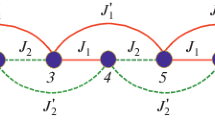Abstract:
A bond-disordered two-dimensional Ising model is used to simulate Kauzmann's mechanism of vitrification in liquids, by a Glauber Monte Carlo simulation. The rearrangement of configurations is achieved by allowing impurity bonds to hop to nearest neighbors at the same rate as the spins flip. For slow cooling, the theoretical minimum energy configuration is approached, characterized by an amorphous distribution of locally optimally arranged impurity bonds. Rapid cooling to low temperatures regularly finds bond configurations of higher energy, which are both a priori rare and severely restrictive to spin movement, providing a simple realization of kinetic vitrification. A supercooled liquid regime is also found, and characterized by a change in sign of the field derivative of the spin-glass susceptibility at a finite temperature.
Similar content being viewed by others
Author information
Authors and Affiliations
Additional information
Received 3 August 2000 and Received in final form 9 March 2001
Rights and permissions
About this article
Cite this article
Lazić, P., Sunko, D. Vitrification in a 2D Ising model with mobile bonds. Eur. Phys. J. B 21, 595–603 (2001). https://doi.org/10.1007/s100510170170
Issue Date:
DOI: https://doi.org/10.1007/s100510170170




